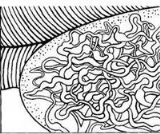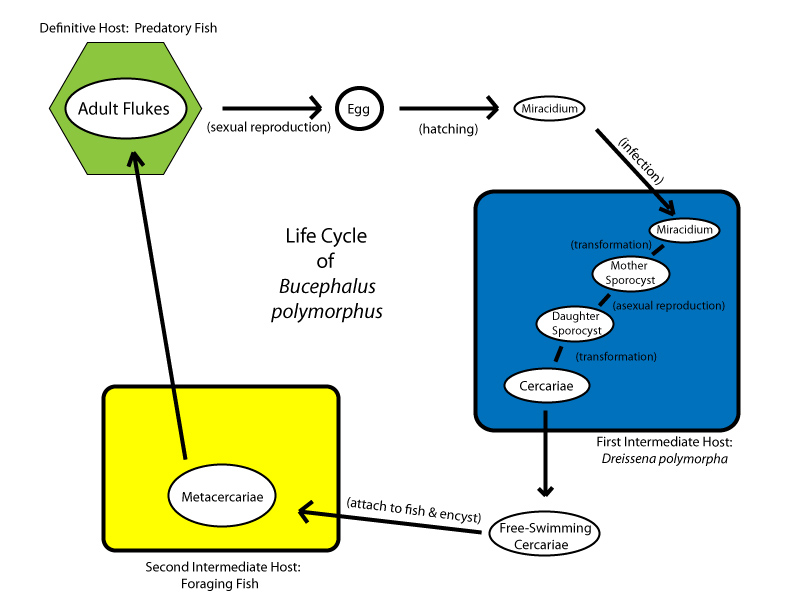
Bucephalus polymorphus
Encyclopedia
Bucephalus polymorphus is a species of the Bucephalidae family of Digenea
, a subclass of Trematodes within the phylum Platyhelminthes. It is characterized by having a mouth near middle of body along with a sac-like gut. The adults occur in the centre of the ventral surface. The adults occur in the gut of marine and fresh-water fish. The metacercariae encyst in smaller fish, sometimes in the nervous system. These parasitic flatworms are dorso-ventrally flattened animals characterized by a bilaterally symmetrical body enclosed within a syncytial tegument. They have a distal, anucleate later (distal cytoplasm). The distal cytoplasm contains vesicular inclusions that are Golgi derived. The adults of these acoelomate worms are common in the digestive tract, but are also found in other organs of vertebrates. The adult parasite attaches via a characteristic anterior adhesive organ with tentacles. Bucephalus are native to North American fresh waters that parasitize freshwater bivalves.
. Within the visceral mass of Dreissena
, the miracidium transforms into a mother (primary) sporocyst
. Asexual reproduction produces many daughter (secondary) sporocysts, which eventually become cercariae. Rapid proliferation of sporocysts results in a knotted white mass of tubules, which is found primarily in the gonads of the mussel. Released from the infected mussels, cercariae attach to fish (second intermediate host), encyst, and transforms into metacercariae. The third (definitive) hosts are predatory fish that consume the infected foraging fish. It has been shown experimentally that cercarial emergence exhibits a circadian rhythm
of shedding with a peak in the dark period of a light:dark 12:12 h photoperiod .

, which left the entire gonadal space often occupied by the sporocysts. By limiting the infection almost exclusively to the gonads, the parasites have developed an interesting strategy to only use the reproductive energy of their hosts, thereby minimizing the risk of host mortality. Extending the life of a bucephalus infected host is important because this allows the parasite to proliferate continuously from year to year, since infected gonads produce cercariae instead of gametes. The location of the sporocyst (primarily in gonads), its overall shape, irregular branches, and the morphology of its cercariae with a bifurcated tail, distinguish B. polymorphus from other trematode parasites of zebra mussels in histological sections.
Digenea
Digenea is a subclass within the Platyhelminthes consisting of parasitic flatworms with a syncytial tegument and, usually, two suckers, one ventral and one oral. Adults are particularly common in the digestive tract, but occur throughout the organ systems of all classes of vertebrates...
, a subclass of Trematodes within the phylum Platyhelminthes. It is characterized by having a mouth near middle of body along with a sac-like gut. The adults occur in the centre of the ventral surface. The adults occur in the gut of marine and fresh-water fish. The metacercariae encyst in smaller fish, sometimes in the nervous system. These parasitic flatworms are dorso-ventrally flattened animals characterized by a bilaterally symmetrical body enclosed within a syncytial tegument. They have a distal, anucleate later (distal cytoplasm). The distal cytoplasm contains vesicular inclusions that are Golgi derived. The adults of these acoelomate worms are common in the digestive tract, but are also found in other organs of vertebrates. The adult parasite attaches via a characteristic anterior adhesive organ with tentacles. Bucephalus are native to North American fresh waters that parasitize freshwater bivalves.
Taxonomy
The genus Bucephalus was based on this species, which was the earliest known, initially described by Baer (1827) from its cercaria. Von Siebold (1848) believed that the adult bucephalid he named Gasterostomum fimbriatum represented an adult form of the same bucephalid, but this identity has never been proven.Life cycle
Dignetic flatworm species require more than one host to complete a full life cycle. Bucephalus polymorphus requires three hosts. Dreissena polymorpha, a small freshwater mussel, is the first intermediate host parasitized by the hatching miracidiumMiracidium
Trematodes are small parasitic flatworms that use vertebrates as their definitive host, and molluscs as their intermediate host. In order to accomplish this, they have several varied lifecyle stages....
. Within the visceral mass of Dreissena
Dreissena
Dreissena is a genus of small freshwater mussels in the family Dreissenidae.-Species:* Dreissena polymorpha, the zebra mussel** Dreissena polymorpha polymorpha** Dreissena polymorpha andrusovi* Dreissena bugensis, the quagga mussel...
, the miracidium transforms into a mother (primary) sporocyst
Sporocyst
Sporocyst is a common name of a lifecycle stage in two unrelated groups of species:*Apicomplexa parasites: see Apicomplexa lifecycle stages*Trematode flatworms: see Trematode lifecycle stages...
. Asexual reproduction produces many daughter (secondary) sporocysts, which eventually become cercariae. Rapid proliferation of sporocysts results in a knotted white mass of tubules, which is found primarily in the gonads of the mussel. Released from the infected mussels, cercariae attach to fish (second intermediate host), encyst, and transforms into metacercariae. The third (definitive) hosts are predatory fish that consume the infected foraging fish. It has been shown experimentally that cercarial emergence exhibits a circadian rhythm
Circadian rhythm
A circadian rhythm, popularly referred to as body clock, is an endogenously driven , roughly 24-hour cycle in biochemical, physiological, or behavioural processes. Circadian rhythms have been widely observed in plants, animals, fungi and cyanobacteria...
of shedding with a peak in the dark period of a light:dark 12:12 h photoperiod .

Influence on Host
B. polymorphus is a parasite residing exclusively in host connective tissues. The gonads of its first intermediate host, Dreissena, is the primary target of infection and sporocyst proliferation. As infection intensifies, the sporocyst develops branches through connective tissue passages, emerges from the gonads, and can spread into other body regions. Such secondary sites of infection have been previously reported to occur in the digestive glands, the gills, the bundles of adductor muscle, and the mantle epithelium lining the interior of the shells. The study found that the digestive glands of infected bivalves appeared to be relatively normal when compared to full bodied, uninfected specimens. Within the sporocyst, the cercariae existed within a wide range of developmental stages, indicating that its development is asynchronous. It was also observed that heavy infection of the parasite led to host castrationParasitic castration
Parasitic castration is the strategy, by a parasite, of blocking reproduction by its host, completely or in part. For example, Hemioniscus balani, a parasitic castrator of hermaphroditic barnacles, feeds on ovarian fluid, so that its host loses female reproductive ability but still can function as...
, which left the entire gonadal space often occupied by the sporocysts. By limiting the infection almost exclusively to the gonads, the parasites have developed an interesting strategy to only use the reproductive energy of their hosts, thereby minimizing the risk of host mortality. Extending the life of a bucephalus infected host is important because this allows the parasite to proliferate continuously from year to year, since infected gonads produce cercariae instead of gametes. The location of the sporocyst (primarily in gonads), its overall shape, irregular branches, and the morphology of its cercariae with a bifurcated tail, distinguish B. polymorphus from other trematode parasites of zebra mussels in histological sections.

